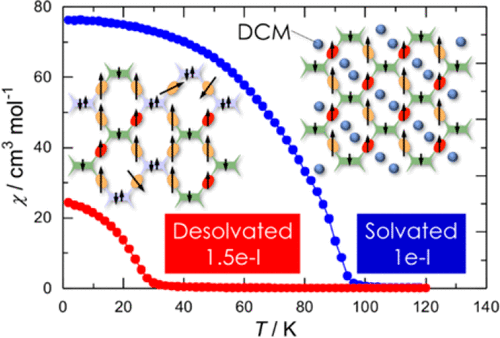当前位置:
X-MOL 学术
›
J. Am. Chem. Soc.
›
论文详情
Our official English website, www.x-mol.net, welcomes your
feedback! (Note: you will need to create a separate account there.)
Magnetic Sponge Behavior via Electronic State Modulations
Journal of the American Chemical Society ( IF 14.4 ) Pub Date : 2018-04-04 , DOI: 10.1021/jacs.8b02428 Jun Zhang 1, 2 , Wataru Kosaka 1 , Kunihisa Sugimoto 3 , Hitoshi Miyasaka 1
Journal of the American Chemical Society ( IF 14.4 ) Pub Date : 2018-04-04 , DOI: 10.1021/jacs.8b02428 Jun Zhang 1, 2 , Wataru Kosaka 1 , Kunihisa Sugimoto 3 , Hitoshi Miyasaka 1
Affiliation

|
A reversible magnetic change in response to external stimuli is a desired function of molecular magnetic materials. The magnetic change induced by a change in the intrinsic spin is significant because the magnetic change is inevitable and could become drastic. In this study, we demonstrate a reversible magnetic change closely associated with electronic state modulations, as well as structural modifications realized by solvation/desolvation cycles of a magnetic sponge. The compound was a D2A-type layered magnet, [{Ru2(O2CPh-2,3,5-Cl3)4}2(TCNQMe2)]·4DCM (1; 2,3,5-Cl3PhCO2- = 2,3,5-trichlorobenzoate; TCNQMe2 = 2,5-dimethyl-7,7,8,8-tetracyanoquinodimethane; DCM = dichloromethane), where [Ru2(O2CPh-2,3,5-Cl3)4] ([Ru2II,II]) is an electron donor (D) and TCNQMe2 is an electron acceptor (A). Compound 1 had a one-electron-transferred, charge-ordered state with a [{Ru2II,II}-TCNQMe2•--{Ru2II,III}+] (1e-I) formula. Strong intralayer antiferromagnetic couplings between [Ru2II,II] with S = 1 or [Ru2II,III]+ with S = 3/2 and TCNQMe2•- with S = 1/2, as well as ferromagnetic interlayer interactions, induced long-range ferrimagnetic ordering at Tc = 101 K. Interstitial DCM molecules were located between layers, and these were gradually eliminated under vacuum at 80 °C to form a solvent-free compound (1-dry) without loss of crystallinity. The electronic state of 1-dry thermally fluctuated and eventually provided a charge-disproportionate disordered state, with a [{Ru2}0.5+-TCNQMe21.5--{Ru2II,III}+] (1.5e-I) formula as the ground state. The Tc in 1-dry was 34 K because of the presence of diamagnetic TCNQMe22- in some parts of the framework. A large Tc variation with Δ Tc ≈ 70 K was switchable; switching was achieved by charge-state modulations accompanied by subtle structural modifications in solvation/desolvation treatments.
中文翻译:

通过电子状态调制的磁海绵行为
响应于外部刺激的可逆磁性变化是分子磁性材料所期望的功能。由内在自旋变化引起的磁变化是显着的,因为磁变化是不可避免的并且可能变得剧烈。在这项研究中,我们展示了与电子状态调制密切相关的可逆磁性变化,以及通过磁性海绵的溶剂化/去溶剂化循环实现的结构修改。该化合物为 D2A 型层状磁体,[{Ru2(O2CPh-2,3,5-Cl3)4}2(TCNQMe2)]·4DCM (1; 2,3,5-Cl3PhCO2- = 2,3,5 -三氯苯甲酸酯;TCNQMe2 = 2,5-二甲基-7,7,8,8-四氰基醌二甲烷;DCM = 二氯甲烷),其中 [Ru2(O2CPh-2,3,5-Cl3)4] ([Ru2II,II]) 是电子供体 (D) 和 TCNQMe2 是电子受体 (A)。化合物 1 有一个单电子转移,具有 [{Ru2II,II}-TCNQMe2•--{Ru2II,III}+] (1e-I) 公式的电荷有序态。[Ru2II,II] 与 S = 1 或 [Ru2II,III]+ 与 S = 3/2 与 TCNQMe2•- 与 S = 1/2 之间的强层内反铁磁耦合,以及铁磁层间相互作用,诱导长程亚铁磁在 Tc = 101 K 时排序。间隙 DCM 分子位于层之间,这些分子在 80 °C 真空下逐渐消除,形成无溶剂化合物 (1-dry),而不会损失结晶度。1-dry 的电子态发生热波动并最终提供电荷不成比例的无序状态,以 [{Ru2}0.5+-TCNQMe21.5--{Ru2II,III}+] (1.5eI) 公式作为基态。由于框架的某些部分存在抗磁性 TCNQMe22-,1-dry 中的 Tc 为 34 K。Δ Tc ≈ 70 K 的大 Tc 变化是可切换的;转换是通过电荷状态调制实现的,伴随着溶剂化/去溶剂化处理中的细微结构修改。
更新日期:2018-04-04
中文翻译:

通过电子状态调制的磁海绵行为
响应于外部刺激的可逆磁性变化是分子磁性材料所期望的功能。由内在自旋变化引起的磁变化是显着的,因为磁变化是不可避免的并且可能变得剧烈。在这项研究中,我们展示了与电子状态调制密切相关的可逆磁性变化,以及通过磁性海绵的溶剂化/去溶剂化循环实现的结构修改。该化合物为 D2A 型层状磁体,[{Ru2(O2CPh-2,3,5-Cl3)4}2(TCNQMe2)]·4DCM (1; 2,3,5-Cl3PhCO2- = 2,3,5 -三氯苯甲酸酯;TCNQMe2 = 2,5-二甲基-7,7,8,8-四氰基醌二甲烷;DCM = 二氯甲烷),其中 [Ru2(O2CPh-2,3,5-Cl3)4] ([Ru2II,II]) 是电子供体 (D) 和 TCNQMe2 是电子受体 (A)。化合物 1 有一个单电子转移,具有 [{Ru2II,II}-TCNQMe2•--{Ru2II,III}+] (1e-I) 公式的电荷有序态。[Ru2II,II] 与 S = 1 或 [Ru2II,III]+ 与 S = 3/2 与 TCNQMe2•- 与 S = 1/2 之间的强层内反铁磁耦合,以及铁磁层间相互作用,诱导长程亚铁磁在 Tc = 101 K 时排序。间隙 DCM 分子位于层之间,这些分子在 80 °C 真空下逐渐消除,形成无溶剂化合物 (1-dry),而不会损失结晶度。1-dry 的电子态发生热波动并最终提供电荷不成比例的无序状态,以 [{Ru2}0.5+-TCNQMe21.5--{Ru2II,III}+] (1.5eI) 公式作为基态。由于框架的某些部分存在抗磁性 TCNQMe22-,1-dry 中的 Tc 为 34 K。Δ Tc ≈ 70 K 的大 Tc 变化是可切换的;转换是通过电荷状态调制实现的,伴随着溶剂化/去溶剂化处理中的细微结构修改。









































 京公网安备 11010802027423号
京公网安备 11010802027423号